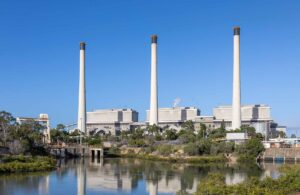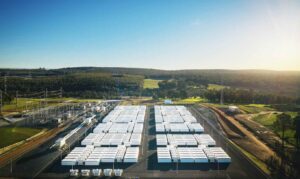Tesla founder and CEO Elon Musk has long predicted the imminent end of the fossil fuel era. But it took a couple of tweets between him and another billionaire, Australia’s Mike Cannon-Brookes, on Friday to highlight just how close this is.
Australia’s fossil fuel “elite” – the industry, the politicians, the regulators and the media – have been kidding themselves that new battery storage technologies are “decades” away from being competitive with coal and gas.

It’s what Australia’s energy ministers were told by the Australian Energy Market Operator at a COAG meeting last year, and US energy giant AES was stunned to find the same levels of ignorance when it spoke to ministers and regulators as recently as last November.
As we reported last Thursday, Tesla announced that the inflection point wasn’t 20 years away. It was 100 days away. That, at least, was the time it would take to build a 100MW battery storage facility in South Australia, once planning approval and a contract had been signed.
 On Friday, when challenged by Cannon-Brookes, the co-founder of Australian software company Atlasssian, if this was just an idle boast, Musk responded – by tweeting – that he would build it for free if it couldn’t be completed within 100 days.
On Friday, when challenged by Cannon-Brookes, the co-founder of Australian software company Atlasssian, if this was just an idle boast, Musk responded – by tweeting – that he would build it for free if it couldn’t be completed within 100 days.
He even offered a “discount price” of $US250/kWh, effectively halving the price of battery storage – for the second time in 12 months.
Depending on how that 100MW is configured, either with two hours of storage or four, that equates to a price of $US50 million for a 200MWh facility or $US100 million for a 400MWh facility. In other words, it is cheaper than gas and can be built in a fraction of the time.
Musk’s Twitter exchange with Cannon-Brookes triggered such a response on social media that he soon had both South Australia premier Jay Weatherill and prime minister Malcolm Turnbull on the phone, and had changed the debate about Australia’s energy future – something that thousands of submissions and endless reports had failed to do.
With any luck, this should be the wake up call needed to shake Australia’s politicians, regulators and media commentators from their delusion that fossil fuels are the only answer to Australia’s so-called energy crisis.
This assumption has been ruthlessly exploited by the “traditional” energy industry to call for a curb on new wind and solar farms, for the building of new “clean coal” plants and for the opening of coal seam gas reserves across the country – all in the name of so-called cheap, reliable and clean energy.
Of course, Tesla is not the first company to make the now obvious point that the solution relies not in new coal and gas plants, but in wind, solar and battery storage. But it helps to get media and public attention when two youngish, fashionable billionaires decide they can fix the country’s energy “crisis” in a Twitter conversation.
Professor Ross Garnaut, whose roles now included being chair of Zen Energy, said late last year that a large-scale battery storage of the size contemplated by Tesla could be built in South Australia by the end of summer.
AES said pretty much the same things last month, when it told a Senate committee that battery storage was already competitive and could solve South Australia’s, and Australia’s, energy security challenge. Carnegie has also been saying the same thing, as have software companies such as Reposit Power and others in the immediate aftermath of South Australia’s “system black” in late September.
The difficulty, they have all been pointing out, is that battery storage is being compared with coal and gas on the basis of only one of its value streams – either providing “peak” power, or grid stability services, known in the industry jargon as FCAS, or dealing with network constraints
Of course, it can do these and a lot more. AES and its local partner, Lyon Solar, cited 20 different values streams of battery storage – things like emergency response, integration of wind and solar variability, and as a significantly cheaper alternative to grid upgrades (deflecting or removing the need for new transformers and poles and wires).
The problem in Australia is that it is impossible for battery storage to exploit those multiple value streams at the same time. Even though battery storage can provide all the different functions of coal and gas, the rules don’t allow it.
The 30 minute settlement rule on wholesale electricity markets, which favours slow response gas generators to quick response battery storage, is just one of those rules that is being fiercely resisted by the fossil fuel industry, and repeatedly delayed by the national rule maker.
Indeed, while the coal and gas industry have lost the environment and economic arguments, they still wield extraordinary power, known as “regulatory capture”, which has helped them stand in the way of the rule changes needed to redesign Australia’s energy market from 20th century clunker, to a cheaper, smarter and cleaner grid of the 21st century.
Those rules have allowed the fossil fuel generators to build up extraordinary market power, enabling them to act with impunity when withdrawing capacity, forcing up prices to ridiculous heights this past summer, choosing to leave equipment in mothballs and creating fuel shortages – as they have done most cynically – with the gas market.
As the old expression goes, give them enough rope and they will hang themselves.

The coal and gas generators can no longer even claim they are reliable. They have repeatedly failed in times of crisis and melted in the heat. Gas plants and coal plants have repeatedly tripped at times of high demand.
In the height of the January heat wave, the market operator had to intervene and take extraordinary action to protect the NSW grid, in case the modern Kogan Creek coal generator in south-west Queensland tripped and triggered a voltage collapse that could have switched the lights out in NSW.
As Musk has pointed out, the fossil fuel industry has been able to sow doubt and confusion about new technologies because they are powerful:
“They have more money and more influence than any other sector,” he said in an interview last year. “So I think the more that there can be a sort of popular uprising against that the better.”
Hopefully, these tweets, can help inject some sanity and some reality in Australia’s energy debate, and puncture the stubborn ideology that has prevented the Coalition, and much of mainstream media, from making any intelligent contribution.
As battery storage industry insiders were saying this weekend, if the rules were changed to allow the “big three” services of grid offerings – peak, constraints and FCAS – then it would be “game on”. The industry would never look the same again.
One thing these tweets and sudden government engagement must do is to bring some sense of reality to the modelling that goes into the big assumptions and policy proposals.
Last week, again, we took issue with the blind support of an emissions intensity scheme, not because we don’t like an EIS, per se, but because we don’t think policy choices should be made on the assumptions of technology costs that are two decades out of date.
It could well be, as the Clean Energy Finance Corporation has suggested, more prudent, more efficient and less costly to identify where new power sources and new back-up is needed, and structure a series of auctions to find the cheapest price.
This is where the Finkel review can play a critically important role. Introduce some sanity about technology costs – let’s aim for solar and wind at well below $100/MWh and battery storage at less $250/kWh – and smash through the regulatory protections.
And when he is finished, in June, perhaps then Finkel can tweet the conclusions. That way, he can guarantee that the politicians will read it.








